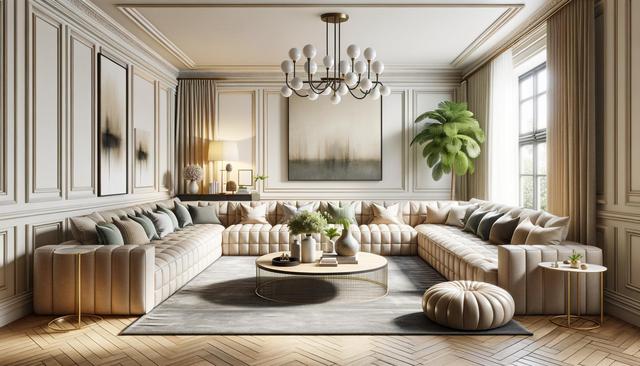
Maximizing Space and Style: Your Guide to Modern Living with Modular Seating Furniture
What Is Modular Seating and Why It Works
Modular seating refers to furniture pieces designed to be rearranged or combined in multiple configurations, offering a high level of adaptability in modern living spaces. Particularly beneficial for apartments, studios, or multipurpose rooms, modular seating is crafted to meet the changing needs of households. Unlike traditional sofas or sectionals, modular units can be separated, expanded, or reoriented, making them a valuable choice for dynamic lifestyles.
One of the key advantages of modular seating is its ability to optimize space without sacrificing comfort or design. Because each piece is self-contained, you can tailor your layout based on the room’s dimensions or your preferences. This makes it easier to:
- Accommodate guests with additional seating when needed
- Redesign your layout without investing in new furniture
- Adapt your space for different purposes, such as work, relaxation, or social gatherings
From L-shaped arrangements to U-shaped lounges, the possibilities are extensive. This flexibility helps homeowners embrace a minimalist approach while maximizing the functionality of their living area.
Space-Saving Solutions for Urban Living
In urban environments where space is often at a premium, modular seating provides a strategic solution for compact living rooms. These versatile furniture pieces ensure every square foot serves a purpose, enhancing both visual appeal and utility. Modular furniture often includes hidden storage, pull-out elements, or convertible features, which support efficient use of space without crowding the room.
Some space-saving ideas with modular seating include:
- Using ottomans with built-in storage to reduce clutter
- Choosing low-profile modules to create an open and airy feel
- Stackable or nesting components for easy rearrangement
By selecting modular pieces that serve multiple functions, you can maintain a clean, streamlined aesthetic while meeting everyday needs. This design approach is especially useful for families or individuals who require flexibility in a shared space, such as combining a living area with a home office or play zone.
Styling Tips to Balance Form and Function
While modular seating is known for its practicality, it can also be a strong style statement in any living room. The modular approach aligns well with contemporary interior trends that prioritize clean lines, neutral palettes, and functional layouts. Styling your modular furniture effectively can enhance the overall feel of the room, making it both inviting and visually cohesive.
To make the most of your modular setup, consider the following tips:
- Use throw pillows and textured blankets to soften the lines and add warmth
- Choose a color scheme that complements the rest of your decor to unify the space
- Incorporate accent pieces like area rugs or wall art for added depth
Modular pieces are often available in a variety of materials and finishes, allowing you to select options that reflect your design preferences. Whether you favor a minimalist Scandinavian look or a more eclectic, cozy atmosphere, modular seating can be tailored to suit your taste without compromising on function.
Adapting to Changing Lifestyles
One of the greatest strengths of modular seating is its adaptability. As lifestyles evolve—whether through relocation, family growth, or changing daily routines—your furniture should be able to evolve with you. Modular designs allow for this kind of transition without requiring significant reinvestment in new pieces.
For example, a couple living in a one-bedroom apartment may initially use a compact two-piece configuration. As their needs change, they can expand their setup by adding new modules, such as a chaise or additional seats. Similarly, families with children can modify their arrangement to create more open play areas or reading nooks as needed.
In shared living spaces or multi-generational homes, modular seating also allows everyone to customize their corner of the room. This can foster a sense of personal space while keeping the overall design cohesive. The modular approach ensures that your home remains both functional and comfortable, no matter how your circumstances shift over time.
Choosing the Right Modular Seating for Your Home
Selecting modular seating that fits your lifestyle and interior design requires thoughtful planning. Start by assessing your space—take measurements and consider how the room is used daily. Think about how many people typically use the space, whether you entertain often, and what other functions your living room serves.
Key factors to consider when choosing modular seating include:
- Material durability and ease of maintenance
- Color and fabric options that match your interior design
- Expandability and compatibility with future modules
- Comfort and ergonomic support
Visiting a showroom or viewing detailed product images online can help you visualize how different configurations will look in your home. Some retailers offer modular sets that can be customized through online tools, allowing you to create a layout that works for your specific needs and style preferences. Taking these steps ensures your investment in modular seating enhances your living space for years to come.
Conclusion: A Smart Design Choice for Modern Living
Modular seating is more than a trend—it’s a practical and stylish response to the evolving needs of modern living. Whether you’re working with limited space or seeking a flexible design solution, modular furniture offers a way to balance comfort, usability, and visual appeal. By understanding how to incorporate these adaptable pieces into your living room, you can create a space that reflects your lifestyle while remaining inviting and functional. For those looking to maximize both space and style, modular seating presents a thoughtful and long-term solution that aligns with contemporary living values.